Visualization and Interpretation of Life Cycle Sustainability Assessment—Existing Tools and Future Development
Abstract
1. Introduction
2. State-of-the-Art in LCSA Visualization
2.1. Life Cycle Sustainability Dashboard
2.2. Sustainability Crowns
2.3. Triangles
2.3.1. Life Cycle Sustainability Triangle
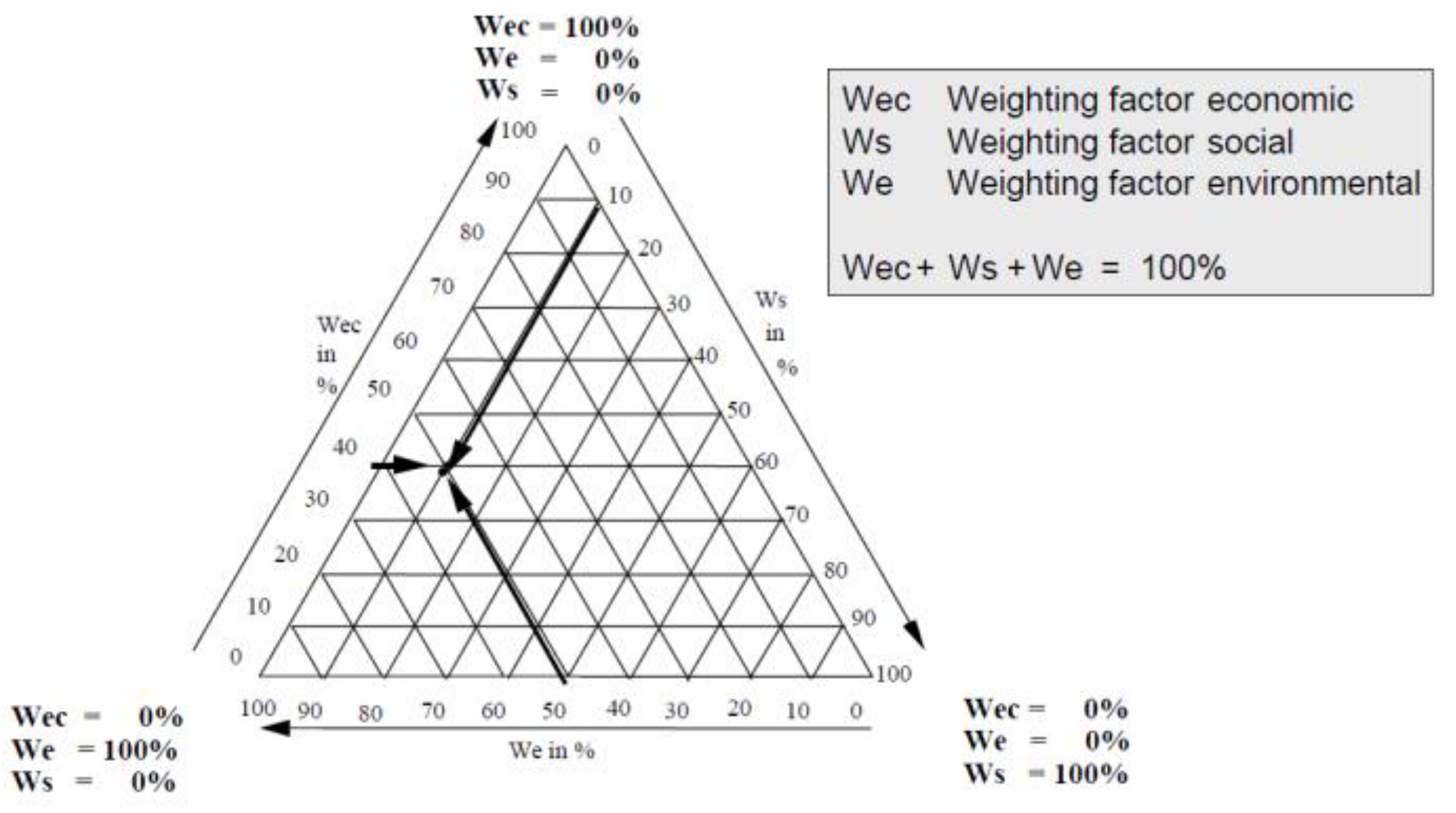
2.3.2. A Posterior Triangle/PS(S)M
2.3.3. Three-Sided Triangle
2.3.4. Integrative Triangle
3. Analysis of Existing Tools
3.1. Methodology
Goals for the Creation of a Targeted Visualization
3.2. Results
3.2.1. LCSD
3.2.2. Crowns
3.2.3. LCST
3.3. Discussion
4. Theoretical Future Development—Visualization Tool: LCSA-Wheel
4.1. LCSA-Wheel
Meeting the Target Criteria
4.2. Practical Example of Carbon Reinforced Concrete
4.3. Discussion & Limitation
5. Conclusions
- The Life Cycle Sustainability Triangle is rather unsuitable as an objectively usable interpretation approach in practice since the calculations for the sustainability assessment are made only after the visualization has been used to aid weighting and are thus dependent on subjective weightings. It is therefore recommended as an additional tool for decision support.
- The Life Cycle Sustainability Dashboard is a very comprehensive visualization tool for LCSA results. It provides the user with some information, but it lacks a fixed and structured structure, which makes the application of the visualization very difficult.
- The Sustainability Crowns are only intended to help the user weigh the sustainability dimensions and therefore do not map overall results. Nevertheless, the Sustainability Crowns fulfill most of the established target criteria and have an intuitively understandable structure.
- A circular illustration was supplemented by a frame that provides the user with further information, such as mathematical explanations of the calculations. Furthermore, the overall results were vividly added to the center of the LCSA-Wheel, as these form the core of the visualization.
- It can be chosen from multiple print versions: The first includes the LCSA-Wheel with a QR code, which can be used to access the stored data basis in the form of a website. The second print version supplements the LCSA-Wheel with a table that lists information about the evaluation criteria used.
- Flexible application is possible by adjusting the number of evaluation criteria and the sustainability dimensions.
Supplementary Materials
Author Contributions
Funding
Informed Consent Statement
Data Availability Statement
Conflicts of Interest
References
- Guinée, J.B.; Heijungs, R.; Huppes, G.; Zamagni, A.; Masoni, P.; Buonamici, R.; Ekvall, T.; Rydberg, T. Life cycle assessment: Past, present, and future. Environ. Sci. Technol. 2011, 45, 90–96. [Google Scholar] [CrossRef]
- Backes, J.G.; Traverso, M. Application of Life Cycle Sustainability Assessment in the Construction Sector: A Systematic Literature Review. Processes 2021, 9, 1248. [Google Scholar] [CrossRef]
- Valdivia, S.; Backes, J.G.; Traverso, M.; Sonnemann, G.; Cucurachi, S.; Guinée, J.B.; Schaubroeck, T.; Finkbeiner, M.; Leroy-Parmentier, N.; Ugaya, C.; et al. Principles for the application of life cycle sustainability assessment. Int. J. Life Cycle Assess. 2021, 26, 1900–1905. [Google Scholar] [CrossRef]
- Traverso, M.; Finkbeiner, M.; Jørgensen, A.; Schneider, L. Life Cycle Sustainability Dashboard. J. Ind. Ecol. 2012, 16, 680–688. [Google Scholar] [CrossRef]
- Finkbeiner, M.; Schau, E.M.; Lehmann, A.; Traverso, M. Towards life cycle sustainability assessment. Sustainability 2010, 2, 3309–3322. [Google Scholar] [CrossRef]
- Kloepffer, W. Life cycle sustainability assessment of products. Int. J. Life Cycle Assess. 2008, 13, 89–95. [Google Scholar] [CrossRef]
- Zanni, S.; Awere, E.; Bonoli, A. Life Cycle Sustainability Assessment: An Ongoing Journey; Elsevier Inc.: Amsterdam, The Netherlands, 2020. [Google Scholar] [CrossRef]
- Balasbaneh, A.T.; Yeoh, D.; Juki, M.I.; Gohari, A.; Abidin, A.R.Z.; Marsono, A.K.B. Applying three pillar indicator assessments on alternative floor systems: Life cycle study. Int. J. Life Cycle Assess. 2021, 26, 1439–1455. [Google Scholar] [CrossRef]
- Raymond, A.J.; Kendall, A.; DeJong, J.T.; Kavazanjian, E.; Woolley, M.A.; Martin, K.K. Life Cycle Sustainability Assessment of Fugitive Dust Control Methods. J. Constr. Eng. Manag. 2021, 147, 04020181. [Google Scholar] [CrossRef]
- Touceda, M.I.; Neila, F.J.; Degrez, M. Modeling socioeconomic pathways to assess sustainability: A tailored development for housing retrofit. Int. J. Life Cycle Assess. 2018, 23, 710–725. [Google Scholar] [CrossRef]
- Fauzi, R.T.; Lavoie, P.; Sorelli, L.; Heidari, M.D.; Amor, B. Exploring the current challenges and opportunities of Life Cycle Sustainability Assessment. Sustainability 2019, 11, 636. [Google Scholar] [CrossRef]
- Brühl, W.; Ebinger, F.; Ewen, C. Hoechst nachhaltig. Okol. Wirtsch. Fachz. 1997, 12, 7–10. [Google Scholar] [CrossRef]
- Hardi, P.; Semple, P. The dashboard of sustainability: From a metaphor to an operational set of indices. In Proceedings of the Fifth International Conference on Social Science Methodology, Cologe, Germany, 3–6 October 2000; Volume 1. [Google Scholar]
- Dong, Y.H.; Ng, S.T. A modeling framework to evaluate sustainability of building construction based on LCSA. Int. J. Life Cycle Assess. 2016, 21, 555–568. [Google Scholar] [CrossRef]
- Scipioni, A.; Mazzi, A.; Mason, M.; Manzardo, A. The Dashboard of Sustainability to measure the local urban sustainable development: The case study of Padua Municipality. Ecol. Indic. 2009, 9, 364–380. [Google Scholar] [CrossRef]
- Mori, K.; Christodoulou, A. Review of sustainability indices and indicators: Towards a new City Sustainability Index (CSI). Environ. Impact Assess. Rev. 2012, 32, 94–106. [Google Scholar] [CrossRef]
- Camana, D.; Manzardo, A.; Fedele, A.; Toniolo, S. Methods in Sustainability Science: Assessment, Prioritization, Improvement, Design and Optimization; Ren, J., Ed.; Elsevier Inc.: Amsterdam, The Netherlands, 2021; pp. 135–152. [Google Scholar] [CrossRef]
- Traverso, M.; Asdrubali, F.; Francia, A.; Finkbeiner, M. Towards life cycle sustainability assessment: An implementation to photovoltaic modules. Int. J. Life Cycle Assess. 2012, 17, 1068–1079. [Google Scholar] [CrossRef]
- Benedict, B.A. Understanding Full Life-cycle Sustainability Impacts of Energy Alternatives. Energy Procedia 2017, 107, 309–313. [Google Scholar] [CrossRef]
- Corona, B.; San Miguel, G. Life cycle sustainability analysis applied to an innovative configuration of concentrated solar power. Int. J. Life Cycle Assess. 2019, 24, 1444–1460. [Google Scholar] [CrossRef]
- Müller, D.P.; Hiete, M. Visualization supported corporate decision making for life cycle sustainability assessment—Illustrated using a case study for selecting a sustainable packaging system for self-leveling compounds. J. Clean. Prod. 2021, 313, 127768. [Google Scholar] [CrossRef]
- Hofstetter, P.; Braunschweig, A.; Mettier, T.; Müller-Wenk, R.; Tietje, O. The mixing triangle: Correlation and graphical decision support for LCA-based comparisons. J. Ind. Ecol. 1999, 3, 97–115. [Google Scholar] [CrossRef]
- Omran, N.; Sharaai, A.H.; Hashim, A.H. Visualization of the sustainability level of crude palm oil production: A life cycle approach. Sustainability 2021, 13, 1607. [Google Scholar] [CrossRef]
- Penn, M.R.; Fields, K.M. A new framework for teaching the triple bottom line: The sustainability triangle and the sustainability index. In Proceedings of the 2017 ASEE Annual Conference & Exposition, Columbus, OH, USA, 25–28 June 2017. [Google Scholar] [CrossRef]
- Von Hauff, M.; Kleine, A. Methodological approach for the systematisation of the areas of action and the indicators of a sustainability strategy: The integrative sustainability triangle. Int. J. Environ. Sustain. Dev. 2006, 5, 372–394. [Google Scholar] [CrossRef]
- Schumann, H.; Müller, W. Visulaisierung—Grundlagen und allgemeine Methoden; Springer: Berlin/Heidelberg, Germany, 1999. [Google Scholar] [CrossRef]
- Backes, J.G.; Traverso, M. Life Cycle Sustainability Assessment—A Survey Based Potential Future Development for Implementation and Interpretation. Sustainibility 2021, 13, 13688. [Google Scholar] [CrossRef]
- Capitano, C.; Traverso, M.; Rizzo, G. Life Cycle Sustainability Assessment: An implementation to marble products. In Proceedings of the Life Cycle Management Conference LCM, Stuttgart, Germany, 1–8 September 2011. [Google Scholar]
- Zortea, R.B.; Maciel, V.G.; Passuello, A. Sustainability assessment of soybean production in Southern Brazil: A life cycle approach. Sustain. Prod. Consum. 2018, 13, 102–112. [Google Scholar] [CrossRef]
- Backes, J.G.; Traverso, M.; Horvath, A. Environmental assessment of a disruptive innovation: Comparative cradle-to-gate life cycle assessments of carbon-reinforced concrete building component. Int. J. Life Cycle Assess. 2022, 28, 16–37. [Google Scholar] [CrossRef]
- Backes, J.G.; Marzia, B. Social Life Cycle Assessment in the Construction Industry: Systematic Literature Review and Identification of Relevant Social Indicators for Carbon Reinforced Concrete; Springer: Berlin/Heidelberg, Germany, 2023. [Google Scholar] [CrossRef]
- Tarne, P.; Lehmann, A.; Finkbeiner, M. Introducing weights to life cycle sustainability assessment—How do decision-makers weight sustainability dimensions? Int. J. Life Cycle Assess. 2019, 24, 530–542. [Google Scholar] [CrossRef]
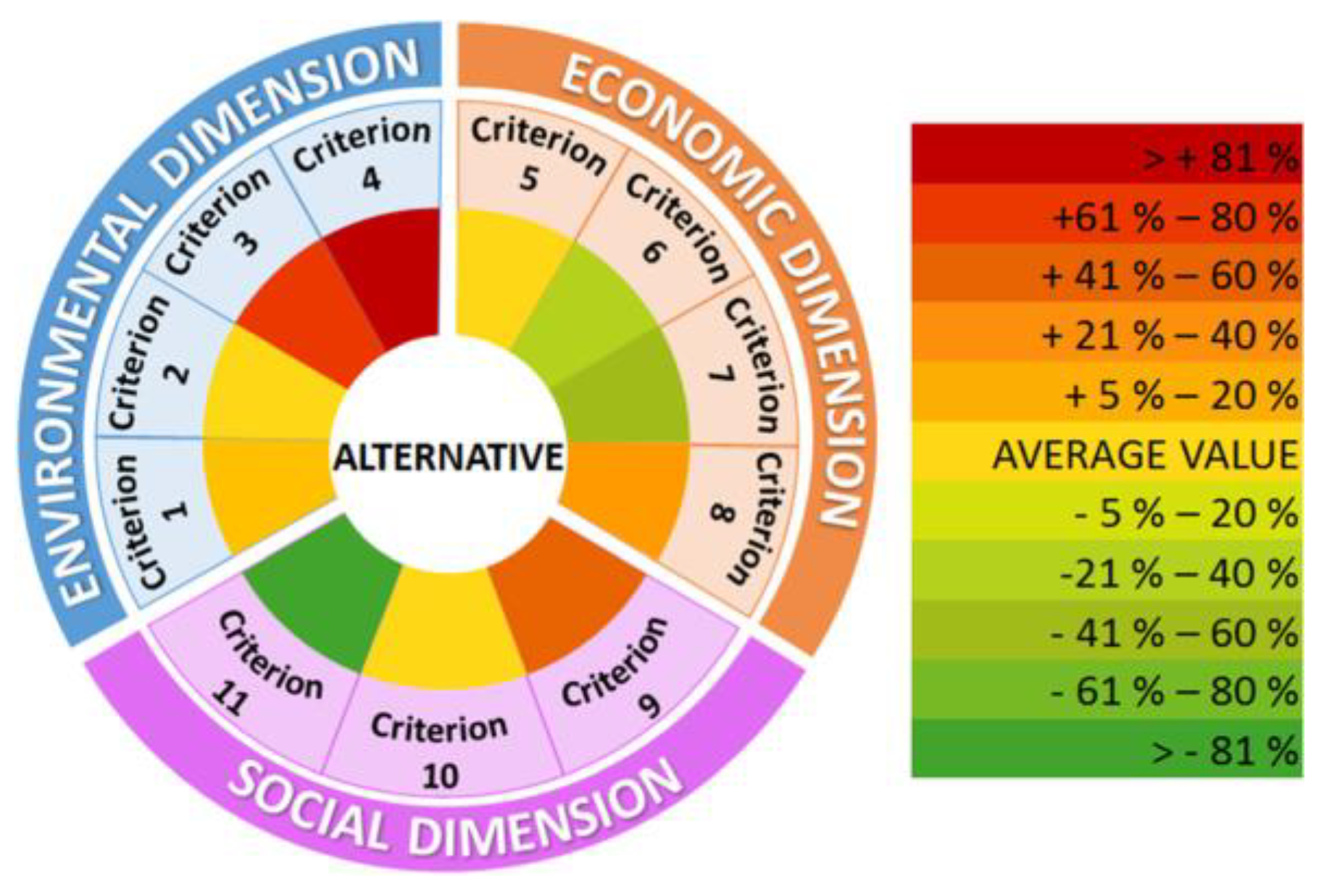
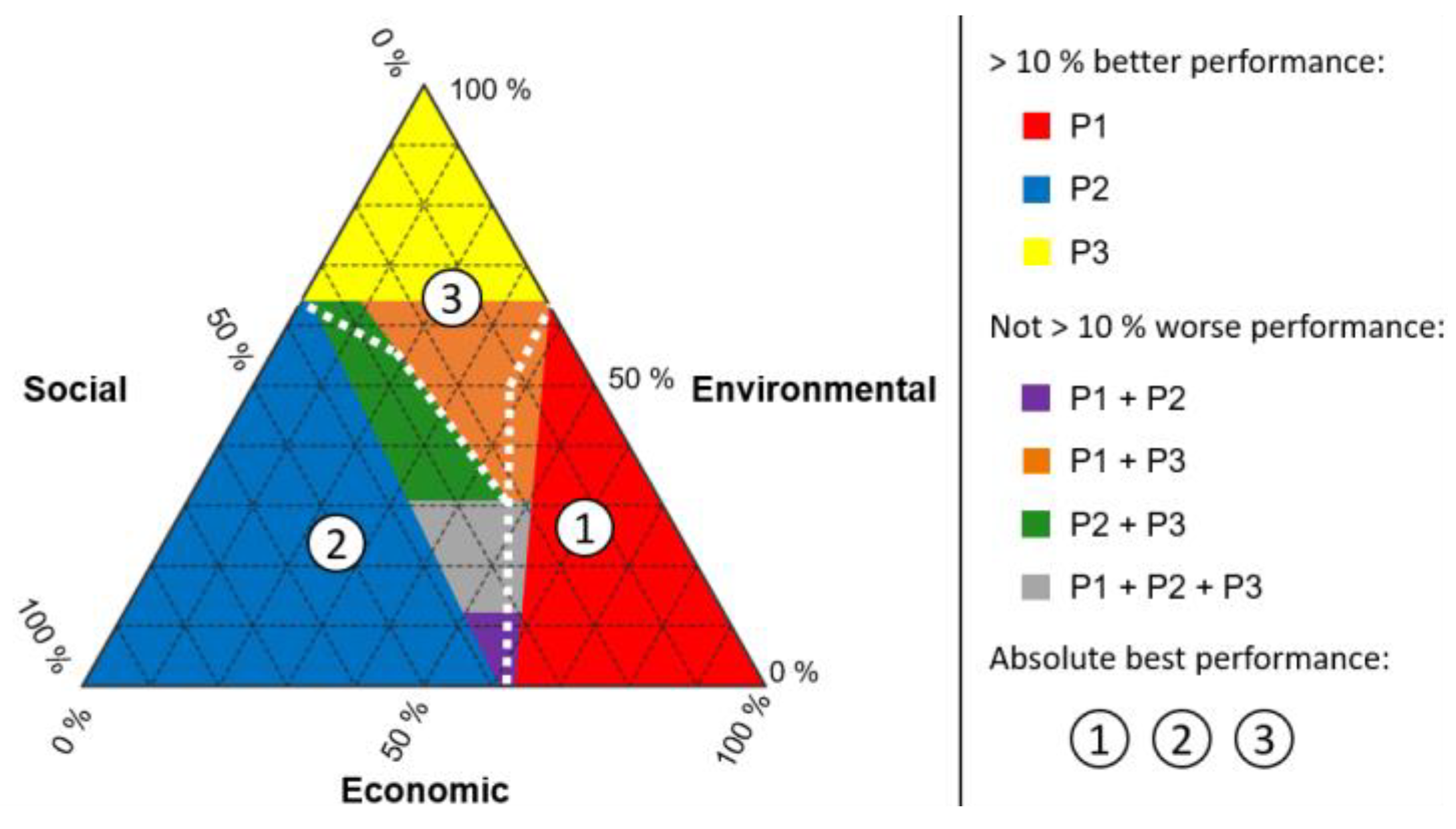
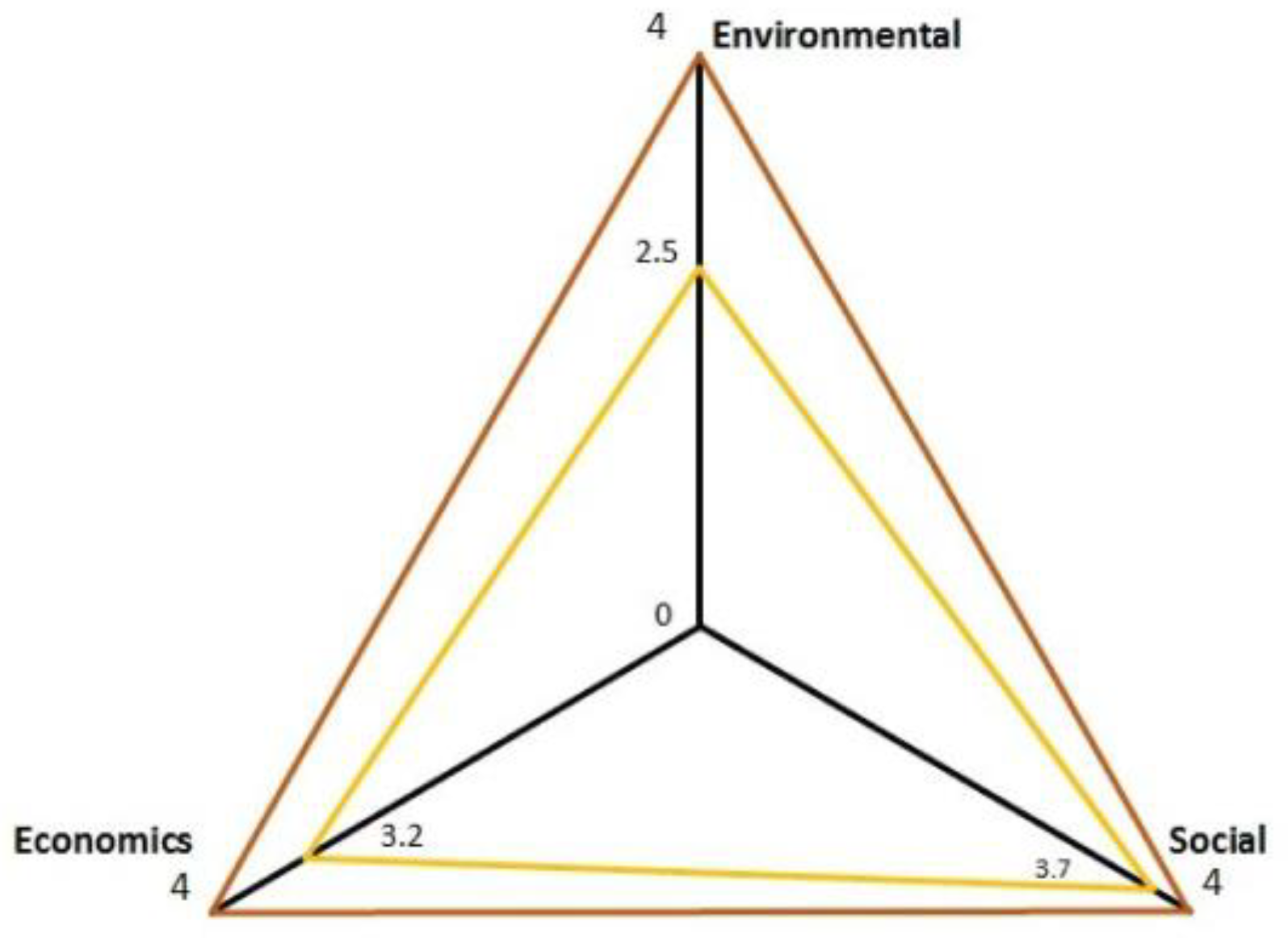
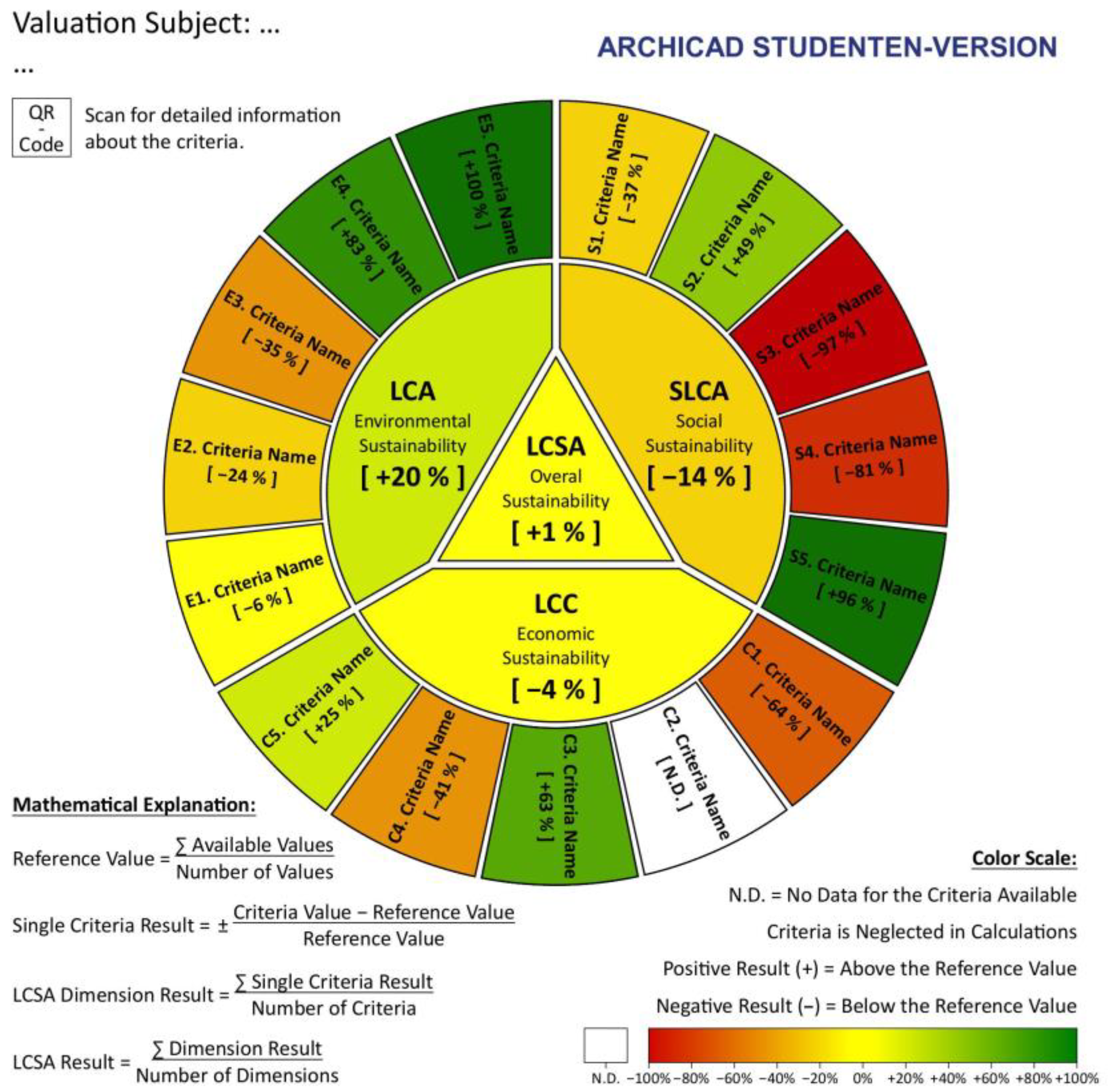
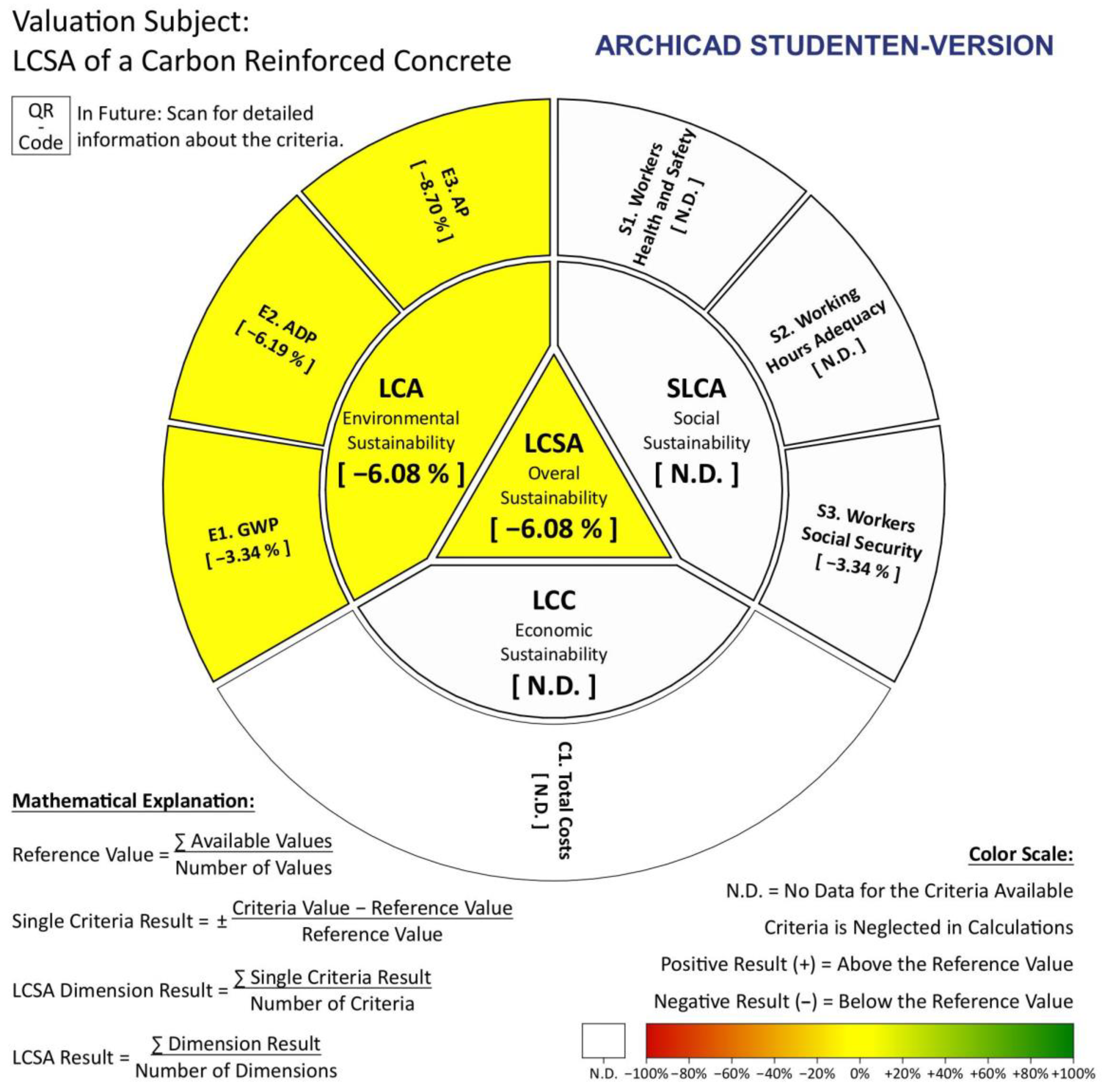
| Visualization | LCST | LCSD | Crowns | ||
|---|---|---|---|---|---|
| 1 | Expressivity | Mapping of an overall result for the LCSA | − | + | − |
| 2 | Mapping the three pillars of the LCSA | − | + | ± | |
| 3 | Information or at least a reference to the basis of assessment | − | ± | ± | |
| 4 | Effectiveness | Use of a color scale including a corresponding legend | − | + | + |
| 5 | Illustration of numerical results (relative or absolute) | − | ± | ± | |
| 6 | Quantity of the listed information to suitable extent | + | ± | + | |
| 7 | Appropriateness | Global applicability of the visualization and its associated data basis | + | + | + |
| 8 | Simple adaptability for new developments | ± | + | + | |
| 9 | Comprehensibility of the visualization | + | − | + | |
| Concrete 1 = CEM I 42.5; 700 kg Only Portland Cement, Less Quartz Sand | |||
| GWP 100 Years [kg CO2 eq.] | ADP Fossil [MJ] | AP [kg SO2 eq.] | |
| Fiber 1 = Given impregnation; conventional energy use | 754 | 6775 | 1.05 |
| Reference Value | 729 | 6380 | 0.97 |
Disclaimer/Publisher’s Note: The statements, opinions and data contained in all publications are solely those of the individual author(s) and contributor(s) and not of MDPI and/or the editor(s). MDPI and/or the editor(s) disclaim responsibility for any injury to people or property resulting from any ideas, methods, instructions or products referred to in the content. |
© 2023 by the authors. Licensee MDPI, Basel, Switzerland. This article is an open access article distributed under the terms and conditions of the Creative Commons Attribution (CC BY) license (https://creativecommons.org/licenses/by/4.0/).
Share and Cite
Backes, J.G.; Steinberg, L.S.; Weniger, A.; Traverso, M. Visualization and Interpretation of Life Cycle Sustainability Assessment—Existing Tools and Future Development. Sustainability 2023, 15, 10658. https://doi.org/10.3390/su151310658
Backes JG, Steinberg LS, Weniger A, Traverso M. Visualization and Interpretation of Life Cycle Sustainability Assessment—Existing Tools and Future Development. Sustainability. 2023; 15(13):10658. https://doi.org/10.3390/su151310658
Chicago/Turabian StyleBackes, Jana Gerta, Leonie Sophie Steinberg, Alexandra Weniger, and Marzia Traverso. 2023. "Visualization and Interpretation of Life Cycle Sustainability Assessment—Existing Tools and Future Development" Sustainability 15, no. 13: 10658. https://doi.org/10.3390/su151310658
APA StyleBackes, J. G., Steinberg, L. S., Weniger, A., & Traverso, M. (2023). Visualization and Interpretation of Life Cycle Sustainability Assessment—Existing Tools and Future Development. Sustainability, 15(13), 10658. https://doi.org/10.3390/su151310658








